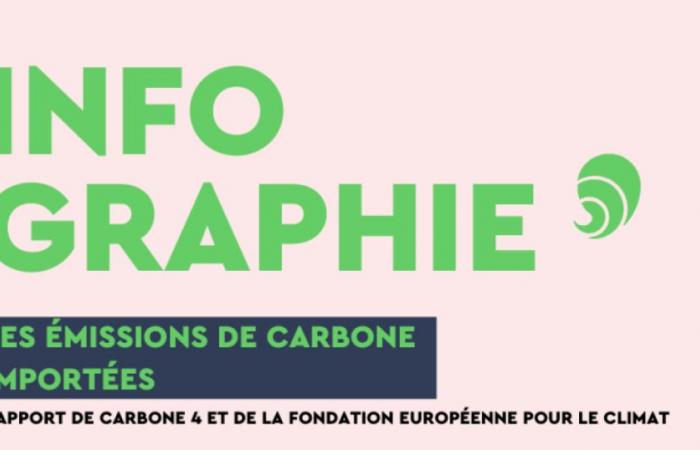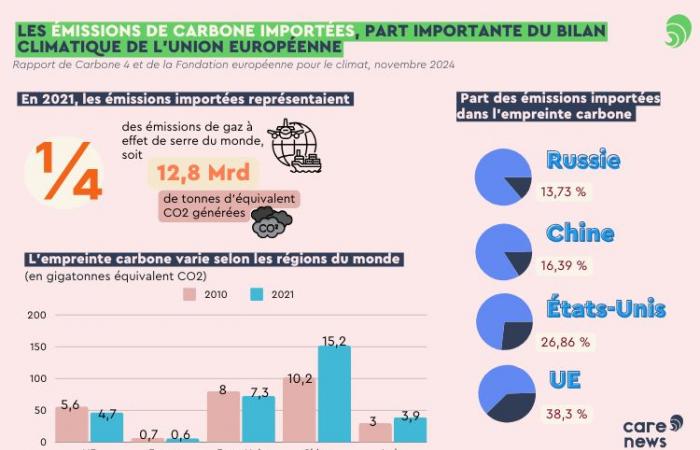A quarter of the world’s greenhouse gas emissions in 2021 were generated by exporting countries to meet demand from importing countries, report consultancy Carbone 4 and the European Climate Foundation (ECF) in a published study Monday November 18.
The report, titled “ Imported emissions: from codependency to cooperative action », looks at the destination countries of goods, whose production emits greenhouse gases. In 2021, nearly 12.8 billion tonnes of CO2 equivalent was generated to produce goods which were then exported to other countries around the world.
France’s carbon footprint in 2021: 639.31 megatons of CO2 equivalent
The authors emphasize the need to take into account “ embodied emissions “, i.e. emissions generated during the production of imported goods, in the calculation of greenhouse gas emissions generated by countries.
To do this, the report uses the carbon footprint method which counts greenhouse gases according to the prism of the final consumption of countries. The latter is calculated as follows: territorial emissions of the country – exported emissions + imported emissions.
This method highlights that in the European Union, many countries (in particular the countries of Northern Europe but also Cyprus, Spain, Portugal and Bulgaria) import more greenhouse gas emissions. greenhouses than they produce.
France for its part produced, in 2021, 443.47 megatons of CO2 equivalent (MtCO2eq) on its territory, but had a higher carbon footprint amounting to 639.31 MtCO2eq. This difference is explained by the fact that France is a “net importer”, that is to say that it imports more emissions than it exports..
Conversely, the countries where the share of imported emissions is the lowest are Russia, Brazil, China, South Africa, Argentina, India and Indonesia. For example, Russia had a carbon footprint in 2021 consisting of 13.73% imported emissions and 86.27% domestic emissions without exports.
China, for its part, had a carbon footprint of 15.2 GtCO2eq in 2021, soit 15 200 MtCO2eq, made up of 16.39% imported emissions and 83.61% national emissions without export.
The risk of carbon leaks
This significant share of emissions imported into European countries carries a risk: that of carbon leaks.
« As countries and regions progress at different rates in their decarbonization efforts, thereby changing their respective competitive positions, it becomes increasingly likely that one country’s reductions could lead to carbon leakage, it is i.e. an increase in emissions from its trading partners », highlight the authors of the report.
The phenomenon of carbon leakage occurs when emissions reduction measures taken by one country lead to making its companies less competitive and to an increase in emissions elsewhere, in regions of the world where production is more carbon intensive.
This factor is all the more to be taken into account as in 2021 the European Union showed strong economic dependence on China and Russiafrom which 20% and 15% of its imported emissions emanated respectively. The effects of sanctions linked to the war in Ukraine are not yet appreciable due to the data stopping at 2021.
Recommendations for more cooperation in reducing GAS
Carbon 4 and ECF point to a predominance of heavy materials and chemicals, agriculture, forestry and fishing, and mining in the carbon footprint of trade, including indirect emissions from electricity and heat used in their production, and international transport.
« Trading partners could recognize their interdependence (my imported consumption = your emissions) to develop, where possible, a cooperative roadmap for sectoral decarbonization », recommend the authors of the report.
In addition to new market rules, they support in particular the possibility of cooperation in reducing greenhouse gas emissions. « International efforts are underway for heavy industries (e.g., the Climate Club, the Leadership Group for Industry Transition, and the Industrial Decarbonization Initiative), but it would be beneficial for the G20 to raise the political profile of this issue », they highlight. The authors cite in particular the recognition of the codependence of countries in terms of reducing emissions, the collection of more precise data on embodied carbon and a consolidation of international initiatives around a common reduction objective.
« Countries may also wish to set voluntary and transparent targets for reducing their imported emissions. » as well as addressing this issue bilaterally “ based on the largest sectoral contributions to their commercial emissions », he adds.
To achieve this, the issue of reducing imported emissions must be incorporated into international discussions, which has not always been the case. “During Cop 21, several participants, including the EU, had a negotiating mandate not to take any measures likely to slow down the development of world trade”write the authors of the report in particular.
This year in Baku for the 29th United Nations climate conference (Cop 29), representatives of the G20 “however, recognize the right to regulate, including for environmental purposes, on this issue of trade and sustainable development”adds Richard Baron, one of the authors of the report and director of the international trade program at ECF.
Élisabeth Crépin-Leblond 








